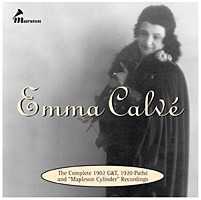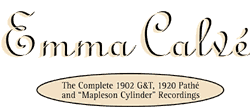
|
Emma Calvé The Complete 1902 G&T, 1920 Pathé and "Mapleson Cylinder" RecordingsEmma Calvé (ca. 1858-1942) achieved immortality as a soprano during the turn of the century and secured a place in history as Carmen. Her beautifully dramatic and wide-ranging voice is captured on this two-CD set. Rounding off the compilation is a selected group of exceedingly rare recordings of Cécile Merguillier (1861-1938), who has the distinction of being one of the last of those agile, full-voiced sopranos légers so popular throughout 19th century French opera. |
|
|

Some artists who made acoustic records were able to overcome the tremendous odds which that primitive recording method imposed on musical reproduction. For despite the limited dynamic and frequency range, it is often surprisingly easy to form a musical image of how those artists sounded in the flesh. Often one is able to hear the subtlest differences in timbre and to make a sensitive evaluation of the performer's artistry. EMI's recently-released promotional recording of tenor Roberto Alagna, issued on a vinyl 78 rpm disc and recorded acoustically, proves that the acoustic process was in some vital musical sense even more accurate than today's recording process.
There were two or three ways in which musical artists overcame the liabilities of acoustic recording. Some had particularly "phonogenic" voices, Caruso of course being the paradigm. Others transcended the inanimate recording horn by projection of indomitable, unique musical personalities. Emma Calvé was a singer of the latter variety--to me her records are among the most remarkable of her day.
Calvé's records seem to accurately reflect the capricious spontaneity so often written about as part of her theatrical persona. We are fortunate to have a small glimpse of Calvé in live musical performance in six Mapleson cylinders recorded at the Metropolitan Opera House, which give us a benchmark by which we can gauge her studio recordings. Calvé's first commercial records were made for the Gramophone Company, the precursor of today's EMI, in London in the spring of 1902. Hearing them today, one can sense the nervous excitement which obviously pervaded the recording studio. Apparently, there was little advance preparation for the session, which gives these discs a spontaneous quality that is charming. The first selection she recorded, the "Habenera" from Carmen, was transposed up a semi-tone. At the conclusion we can hear a few spoken words from Calvé which, though indistinguishable, are surely indicative of her exited relief and pleasure with her own effort. In Massenet's song, "Enchantment," we hear the accompanist Landon Ronald prompting the great (but probably frightened) diva through most of the second stanza. During Calvé's recording of "Magali," Landon Ronald seems to have no idea what sort of accompaniment to play. He finally gives up, leaving Calvé to sing unaccompanied. At least three takes of the "Seguédille" from Carmen were recorded, for takes "1" and "3" were issued. Calvé sings the first take in the original key of F-sharp, but she must have found it uncomfortable as she sings the third take a semi-tone higher. Her final note of this take is noticeably flat, and record lore has it that afterwards Calvé shouts "Ah, mon Dieu!" Careful auditioning of this record reveals that Calvé is merely shouting "Olé!"
This group of discs all play at approximately 75 rpm with some fluctuation within each disc. This is especially apparent in the Carmen "Habenera." I have attempted to minimize this defect but have not been able totally to eliminate it.
Emma Calvé's next group of recordings was made for the Victor Talking Machine company between 1906 and 1916. These all fit conveniently on one CD and have recently been issued on the Romophone label. Therefore, they are not included here.
Sometime during 1920, Calvé made twenty-nine sides for the Pathé Company in Paris. Never released in its entirety, this group contains several rare performances which have not been reissued in any form. Since we don't really know the correct year in which Calvé was born, it is impossible with our current state of knowledge to say exactly how old she was when she made these recordings. But at the very least, she was approaching sixty years of age, and had been singing (and leading a very strenuous life) for nearly forty of those years. Certainly not without flaws, as one would expect from any singer of sixty, Calvé's Pathé performances nevertheless still possess much of the charm, beauty and spontaneity of her earlier recordings. Two selections stand out in my mind as among Calvé's very greatest recordings--Hahn's "L'Heure exquise," and the "Viens avec nous" from Godard's La Vivandière. How fortunate that only six Pathé titles duplicate earlier recordings. Finding the proper pitch for these selections has not been an easy task. I began with the assumption that she probably sang Gounod's "Serenade" in the same key--F--as on her two Victor recrogins of the work. I also assumed that she sang "Voi che sapete" from Mozart's Nozze di Figaro at score pitch. As I continued to work, things began to fall into place and I am now reasonably certain that we have arrived at the correct speeds. I hope you will grow to love Calvé's art as much as I.